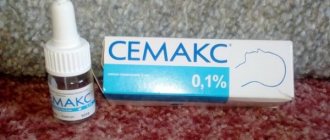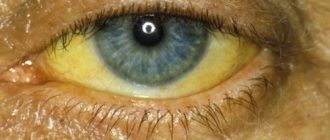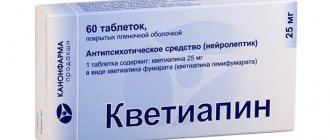Clopixol is a drug from the group of neuroleptics that has pronounced antipsychotic, neuroleptic and sedative effects. Due to the smoothness of side effects, it is used for many psychopathological conditions, varying levels of severity, severity of symptoms and stage of development of pathological processes.
Name: Clopixol
Release form: tablets and solution in ampoules
Indications for the use of clopixol are:
- Mental retardation of unspecified etiology.
- Organic or inorganic mental disorders of unspecified etiology and genesis.
- Various forms of schizophrenia.
- Mental states with severe paranoid disorders.
- Inorganic psychoses of various etiologies.
- Episodic manifestations of depressive disorders.
- Behavioral disorders, including orientation in time and space.
- Cognitive impairment.
- Illusory-hallucinatory complex of unspecified genesis.
- Spontaneous and poorly controlled states of anxiety and agitation.
Release form and composition
Clopixol is available in the form of:
- Film-coated tablets, each of which contains 2, 10 or 25 mg of zuclopenthixol (in the form of zuclopenthixol dihydrochloride) and excipients such as copovidone, magnesium stearate, lactose monohydrate, water-soluble castor oil, potato starch, glycerol, microcrystalline cellulose, talc. The shell contains: titanium dioxide, macrogol, hypromellose and dye – iron oxide (E172);
- An oily solution intended for intravenous administration, 1 ml of which contains 50, 100 or 200 mg of zuclopenthixol and triglycerides as excipients.
Clopixol instructions for use, contraindications, side effects, reviews
Antipsychotic drug (neuroleptic), thioxanthene derivative. Drug: CLOPIXOL Active substance of the drug:
zuclopenthixol ATC coding: N05AF05 KFG: Antipsychotic drug (neuroleptic) Registration number: P No. 014166/01-2002 Registration date: 06/24/02 Registration owner. cred.: H.LUNDBECK A/S {Denmark}
Release form of Clopixol, drug packaging and composition.
Tablets, coated, pale pink, round, biconvex.
1 tab. Zuclopenthixol (as dihydrochloride) 2 mg
Excipients: potato starch, lactose monohydrate, microcrystalline cellulose, copovidone, glycerol 85%, talc, hydrogenated castor oil, magnesium stearate.
50 pcs. - plastic containers. 100 pieces. - plastic containers.
The tablets are pinkish-brown, round, biconvex.
1 tab. Zuclopenthixol (as dihydrochloride) 10 mg
Excipients: potato starch, lactose monohydrate, microcrystalline cellulose, copovidone, glycerol 85%, talc, hydrogenated castor oil, magnesium stearate.
50 pcs. - plastic containers. 100 pieces. - plastic containers.
Red-brown film-coated tablets, round, biconvex.
1 tab. Zuclopenthixol (as dihydrochloride) 25 mg
Excipients: potato starch, lactose monohydrate, microcrystalline cellulose, copovidone, glycerol 85%, talc, hydrogenated castor oil, magnesium stearate.
50 pcs. - plastic containers. 100 pieces. - plastic containers.
DESCRIPTION OF THE ACTIVE SUBSTANCE. All information provided is provided for information only about the drug; you should consult your doctor about the possibility of use.
Pharmacological action of Clopixol
Antipsychotic drug (neuroleptic), thioxanthene derivative. It is believed that the antipsychotic effect of zuclopenthixol is due to the blockade of dopamine receptors in the central nervous system. Thioxanthene derivatives have a high affinity for dopamine D1 and D2 receptors.
Indications for use of Clopixol
As stated in the official instructions, Clopixol is indicated for patients with:
- Schizophrenia;
- Psychotic disorders, in particular with hallucinations, thinking disorders, hostility, aggressiveness, anxiety, agitation, paranoid delusions;
- Manic-depressive psychosis in the manic phase;
- Psychomotor agitation due to mental retardation;
- Senile dementia, accompanied by paranoid ideas, confusion and/or disorientation;
- Paranoid and acute psychosis;
- Manic chronic psychosis in the acute stage.
Clopixol depot instructions for use
The depot form is one of the most effective releases of the drug for the treatment of schizophrenic disorders of any stage and form, with complications of concomitant mental disorders. In addition, this form of the drug clopixol is indicated for various psychotic conditions accompanied by a hallucinatory complex, paranoid delusions, cognitive and intellectual dysfunctions. The drug is also effective in preventing, developing and eliminating increased hostility, anxiety and aggressiveness.
Contraindications
The instructions for Clopixol say that this antipsychotic drug should not be used:
- If you have hypersensitivity to zuclopenthixol or any of the auxiliary components of the drug;
- Patients with acute intoxication with barbiturates, ethanol or opioid analgesics;
- In comatose states;
- Pregnant women;
- During lactation.
It is possible to use Clopixol, but with great caution and under constant medical supervision in case of epileptic syndrome, heart disease (including arrhythmias) or liver disease (including chronic hepatitis).
Directions for use and dosage of Clopixol
Clopixol tablets are taken orally:
- For chronic psychoses and schizophrenia - in a daily dosage of 20-40 mg;
- For acute mental disorders accompanied by mania and severe agitation, as well as during an acute attack of schizophrenia - in a dose of 10 to 50 mg;
- For agitation in patients with oligophrenia - from 6 to 20 mg per day, for severe disorders - from 25 to 40 mg;
- For senile disorders accompanied by confusion and agitation - 2-6 mg once a day, optimally before bedtime. If necessary, the dose is increased to 10 or even 20 mg;
- For severe psychotic disorders, depending on the severity of the disease, from 20 to 75 mg or even more. Increase the dose gradually, every 2-3 days by 10-20 mg.
Clopixol solution is intended for intramuscular injection. A single dosage is 50-150 mg (1-3 ml). If necessary, repeated administration is carried out after 1-3 days. Maintenance therapy is continued with the tablet form of the drug or intramuscular injection of a long-acting solution.
Pharmacological effects
Clopixol has a selective blocking effect on dopaminergic and adrenergic receptors in the midbrain, which accounts for its smooth antipsychotic effect. The sedative effect of the drug is due to the adrenergic blocking effect of neurons of the reticular formation.
The drug poorly passes through the blood-brain barrier and practically does not penetrate into breast milk. It is excreted mainly in feces and slightly in urine. Various renal disorders in the anamnesis do not have a significant effect on the excretion of the drug.
A characteristic feature of the drug is its good therapeutic effect against behavioral disorders, based on which it is often prescribed to patients with dementia and related behavioral disorders.
There is some difference in the effects of the sedative and antipsychotic effects of the drug - after a single injection, the antipsychotic effect occurs within four hours and can last up to three days. The calming effect occurs two hours after administration, reaches a maximum level by eight hours, and then gradually decreases over 10-12 hours.
Side effects of Clopixol
At the initial stages of using Clopixol, extrapyramidal symptoms may develop: impaired motor activity, changes in muscle tone, the appearance of hypokinesia or hyperkinesis and their combinations. In most cases, these signs can be eliminated by reducing the dose and/or additional prescription of antiparkinsonian drugs. However, regular use of the latter for prophylactic purposes is not recommended.
Side effects of Clopixol also include drowsiness, tachycardia, orthostatic dizziness, accommodation paresis, constipation, dry mouth, and urinary retention.
It should be noted that when using all drugs of the neuroleptic group, including Clopixol, in isolated cases the development of NMS, a malignant neuroleptic syndrome with a fatal outcome, is possible. The main signs of this dangerous condition are: muscle rigidity, hyperthermia and impaired consciousness, combined with dysfunction of the autonomic nervous system (increased sweating, tachycardia and labile blood pressure). If the patient develops these symptoms, it is necessary to immediately stop using Clopixol and prescribe symptomatic and supportive therapy.
When this neuropleptic is used in too large doses, arterial hypotension, extrapyramidal disorders, drowsiness, hyper- or hypothermia, coma, and convulsions are possible.
Clopixol
Most adverse reactions are dose-dependent. The incidence of adverse reactions and their intensity are most pronounced in the early stages of treatment and decrease as therapy continues.
Extrapyramidal reactions may occur, especially in the early stages of treatment. In most cases, these adverse reactions are successfully controlled by dose reduction and/or use of antiparkinsonian drugs. However, routine use of antiparkinsonian drugs to prevent adverse reactions is not recommended. They do not improve the symptoms of tardive dyskinesia and may worsen them. Dose reduction or, if possible, discontinuation of zuclopenthixol therapy is recommended. For persistent akathisia, benzodiazepines or propranolol may be helpful.
Information on the incidence of adverse reactions is presented based on literature data and spontaneous reports. The frequency is indicated as: very common (≥1/10), common (≥1/100 to <1/10), uncommon (≥1/1000 to <1/100), rare (≥1/10000 to < 1/1000), very rare (<1/10000), or unknown (cannot be estimated from existing data).
Blood and lymphatic system disorders
: rarely - thrombocytopenia, neutropenia, leukopenia, agranulocytosis.
Immune system disorders:
rarely - hypersensitivity, anaphylactic reactions.
Endocrine system disorders:
rarely - hyperprolactinemia.
Metabolic and nutritional disorders:
often - increased appetite, weight gain; infrequently - loss of appetite, weight loss; rarely - hyperglycemia, impaired glucose tolerance, hyperlipidemia.
Mental disorders:
often - insomnia, depression, anxiety, nervousness, agitation, unusual dreams, decreased libido; infrequently - apathy, increased libido, nightmares, confusion.
Nervous system disorders:
very often - drowsiness, akathisia, hyperkinesis, hypokinesia; often - tremor, dystonia, muscle hypertonicity, dizziness, headache, paresthesia, attention disturbances, amnesia, gait disturbances; uncommon - tardive dyskinesia, hyperreflexia, parkinsonism, fainting, speech disorders, dyskinesia, ataxia, hypotonicity, convulsive disorders, migraine; very rarely - neuroleptic malignant syndrome.
Visual disorders:
often - disturbance of accommodation, visual impairment; infrequently - mydriasis (dilation of the pupil), involuntary movement of the eyeballs.
Hearing and labyrinth disorders:
often - dizziness; infrequently - hyperacusis, tinnitus.
Cardiac disorders:
often - tachycardia, palpitations; rarely - prolonged QT interval on the electrocardiogram.
Vascular disorders:
infrequently - decreased blood pressure, hot flashes; very rarely - venous thromboembolism.
Disorders of
the respiratory system, chest and mediastinal organs:
often - shortness of breath, nasal congestion.
Gastrointestinal disorders:
very often - dry mouth; often - increased salivation, constipation, vomiting, dyspepsia, diarrhea; infrequently - abdominal pain, nausea, flatulence.
Disorders of the liver and biliary tract
: infrequently - changes in laboratory parameters of liver function; very rarely - cholestatic hepatitis, jaundice.
Disorders of the skin and subcutaneous tissues:
often - hyperhidrosis, itching; uncommon - skin rash, photosensitivity, pigmentation disorder, seborrhea, dermatitis, purpura.
Musculoskeletal and connective tissue disorders:
often - myalgia; infrequently - muscle rigidity, trismus, torticollis.
Renal and urinary tract disorders:
often - urinary disorders, urinary retention, polyuria.
Pregnancy, postpartum and perinatal conditions:
unknown - neonatal withdrawal syndrome.
Genital and breast disorders
: uncommon - ejaculation disorders, erectile dysfunction, impaired orgasm in women, vulvovaginal dryness; rarely - galactorrhea, gynecomastia, amenorrhea, priapism.
General and administration site disorders
: often - asthenia, weakness, malaise, pain; infrequently - thirst, hypothermia, pyrexia.
As with other antipsychotic drugs, the following adverse reactions have also been reported when taking zuclopenthixol: in rare cases, prolongation of the QT interval, ventricular arrhythmias - tachycardia and fibrillation, sudden death, cardiac arrest and polymorphic ventricular tachycardia of the "pirouette" type (Torsade de Pointes). ).
Abrupt cessation of taking zuclopenthixol may be accompanied by withdrawal reactions. The most common symptoms are nausea, vomiting, anorexia, diarrhea, rhinorrhea, sweating, myalgia, paresthesia, insomnia, nervousness, anxiety and agitation. Patients may also experience dizziness, sensations of heat and cold, and tremors. Symptoms typically begin within 1-4 days of discontinuation and decrease within 7-14 days.
special instructions
If long-term treatment with Clopixol is necessary, regular monitoring should be carried out to assess the patient's condition and decide on the advisability of reducing the maintenance dosage of the drug.
Zuclopenthixol enhances the sedative effect of drugs that depress the central nervous system, including barbiturates and ethanol.
Clopixol reduces the effect of adrenergic drugs and blocks the hypotensive effect of guanethidine.
It is not recommended to use this drug simultaneously with medications containing piperazine and metoclopramide, as the risk of developing extrapyramidal symptoms increases.
During treatment with Clopixol, you should refrain from driving vehicles and performing tasks that require increased attention and speed of psychomotor reactions.
Drug interactions
Increases the sedative effect of barbiturates, ethanol and other drugs that have a depressant effect on the central nervous system (CNS).
May reduce the effectiveness of levodopa and other adrenergic drugs.
Concomitant use with guanethidine and drugs that have a similar effect is not recommended (since antipsychotics can interfere with their hypotensive effect).
The risk of developing extrapyramidal disorders increases when combined with piperazine and metoclopramide.







